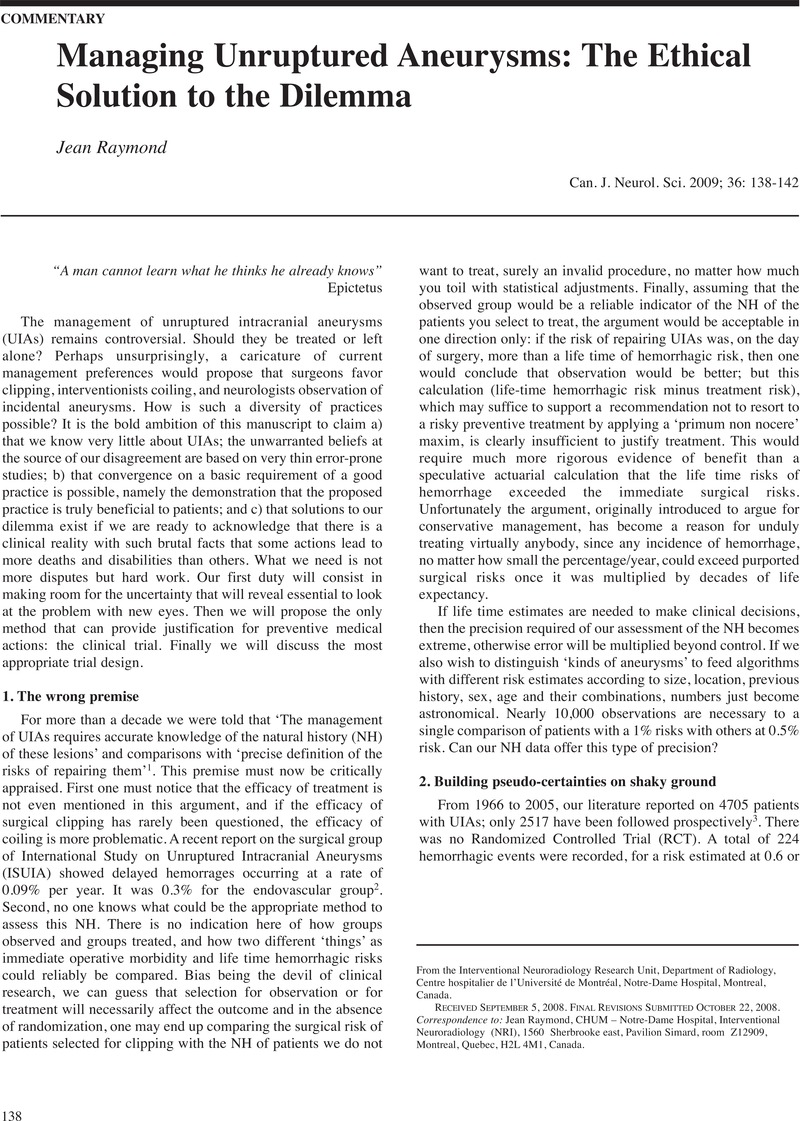Crossref Citations
This article has been cited by the following publications. This list is generated based on data provided by Crossref.
Naggara, Olivier N.
White, Phil M.
Guilbert, François
Roy, Daniel
Weill, Alain
and
Raymond, Jean
2010.
Endovascular Treatment of Intracranial Unruptured Aneurysms: Systematic Review and Meta-Analysis of the Literature on Safety and Efficacy.
Radiology,
Vol. 256,
Issue. 3,
p.
887.
Darsaut, Tim E.
Findlay, J. Max
and
Raymond, Jean
2011.
The Design of the Canadian UnRuptured Endovascular versus Surgery (CURES) Trial.
Canadian Journal of Neurological Sciences / Journal Canadien des Sciences Neurologiques,
Vol. 38,
Issue. 2,
p.
236.
Pelz, David
2011.
CURES and the Dilemma of Unruptured Intracranial Aneurysms.
Canadian Journal of Neurological Sciences / Journal Canadien des Sciences Neurologiques,
Vol. 38,
Issue. 2,
p.
191.
Raymond, Jean
Darsaut, Tim E
and
Molyneux, Andrew J
2011.
A trial on unruptured intracranial aneurysms (the TEAM trial): results, lessons from a failure and the necessity for clinical care trials.
Trials,
Vol. 12,
Issue. 1,
Raymond, Jean
2011.
Reflections on the TEAM Trial: Why Clinical Care and Research Should be Reconciled.
Canadian Journal of Neurological Sciences / Journal Canadien des Sciences Neurologiques,
Vol. 38,
Issue. 2,
p.
198.
Kotowski, M.
Naggara, O.
Darsaut, T.E.
and
Raymond, J.
2012.
Revues systématiques de la littérature sur le clipping et le coiling des anévrismes intracrâniens non rompus.
Neurochirurgie,
Vol. 58,
Issue. 2-3,
p.
132.
Kotowski, M.
Naggara, O.
Darsaut, T.E.
and
Raymond, J.
2012.
Systematic reviews of the literature on clipping and coiling of unruptured intracranial aneurysms.
Neurochirurgie,
Vol. 58,
Issue. 2-3,
p.
125.
Byrne, James Vincent
2012.
Tutorials in Endovascular Neurosurgery and Interventional Neuroradiology.
p.
125.
Castro-Afonso, Luís Henrique de
and
Abud, Daniel Giansante
2015.
Shared decision-making in the context of unruptured intracranial aneurysms management.
Arquivos de Neuro-Psiquiatria,
Vol. 73,
Issue. 9,
p.
791.
Byrne, James Vincent
2017.
Tutorials in Endovascular Neurosurgery and Interventional Neuroradiology.
p.
141.
Magro, Elsa
Gentric, Jean-Christophe
Darsaut, Tim E.
Ziegler, Daniela
MSI
Bojanowski, Michel W.
and
Raymond, Jean
2017.
Responses to ARUBA: a systematic review and critical analysis for the design of future arteriovenous malformation trials.
Journal of Neurosurgery,
Vol. 126,
Issue. 2,
p.
486.
Darsaut, Tim E
Findlay, J Max
Magro, Elsa
Kotowski, Marc
Roy, Daniel
Weill, Alain
Bojanowski, Michel W
Chaalala, Chiraz
Iancu, Daniela
Lesiuk, Howard
Sinclair, John
Scholtes, Felix
Martin, Didier
Chow, Michael M
O’Kelly, Cian J
Wong, John H
Butcher, Ken
Fox, Allan J
Arthur, Adam S
Guilbert, Francois
Tian, Lu
Chagnon, Miguel
Nolet, Suzanne
Gevry, Guylaine
and
Raymond, Jean
2017.
Surgical clipping or endovascular coiling for unruptured intracranial aneurysms: a pragmatic randomised trial.
Journal of Neurology, Neurosurgery & Psychiatry,
Vol. 88,
Issue. 8,
p.
663.
Darsaut, Tim E.
Desal, Hubert
Cognard, Christophe
Januel, Anne-Christine
Bourcier, Romain
Boulouis, Grégoire
Shiva Shankar, Jai Jai
Findlay, J. Max
Rempel, Jeremy L.
Fahed, Robert
Boccardi, Edoardo
Valvassori, Luca
Magro, Elsa
Gentric, Jean-Christophe
Bojanowski, Michel W.
Chaalala, Chiraz
Iancu, Daniela
Roy, Daniel
Weill, Alain
Diouf, Ange
Gevry, Guylaine
Chagnon, Miguel
and
Raymond, Jean
2020.
Comprehensive Aneurysm Management (CAM): An All-Inclusive Care Trial for Unruptured Intracranial Aneurysms.
World Neurosurgery,
Vol. 141,
Issue. ,
p.
e770.
Raymond, J.
Magro, E.
and
Darsaut, T.E.
2022.
Understanding burden of proof and equipoise in the design of pragmatic clinical trials: An example from a trial on brain arteriovenous malformations.
Neurochirurgie,
Vol. 68,
Issue. 6,
p.
608.





